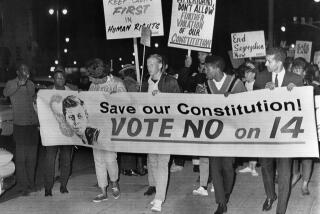Opinion: Despite its cute graphic, Paycheck Fairness Act was evil spawn of Lilly Ledbetter
On Wednesday, the Senate failed, for the third time, to muster the votes to pass the Paycheck Fairness Act, a women’s-vote-wooing initiative of the Obama administration that has been knocking around Congress since President Obama took office in 2009.
Mmm, bad; so whom to blame? How about the Obama administration itself? That’s the theory of the Washington Post’s online feminist columnist Nia-Malika Henderson, who writes:
To illustrate their argument, the White House sent out a shareable graphic, which explains what they are trying to do on equal pay.
It pictures two women, one in a pink dress carrying a handbag, the other in an orange dress, and both are wearing oh-so-practical stilettos. This is exactly what working women wear to work every day, right? All those women who are lawyers, and doctors, and cashiers, and investment bankers, and biochemists, and nursing assistants and architects and engineers and cashiers at the Piggly Wiggly?... This is just not great messaging or symbolism for a White House that wants to also focus on women in minimum wage jobs. It screams “Sex and the City,” not “9 to 5.”
Right, the Paycheck Fairness Act failed because the White House graphic featured a drawing of a couple of women wearing dresses (one pink -- oh my!) and high heels instead of pants and sneakers. Grim socialist realism is the only permissible artistic style in the feminist polity.
Actually, that graphic was the best thing about the Paycheck Fairness Act. It had a pleasing retro look to it, with its two women silhouetted in elegant Jackie Kennedy period attire. It was a subtle reminder that the Equal Pay Act of 1963, which the Paycheck Fairness Act purported to amend, was passed with the enthusiastic support of Jackie’s soon-to-be-assassinated husband (and, I might add for the record, every single Republican in Congress at the time).
As for the Paycheck Fairness Act itself, it was a turkey of a bill about which I hope someone will finally say, “Three’s a charm -- time for the chopping block.”
To switch metaphors ever so slightly, it was one of what I call the evil spawn of Lilly Ledbetter. Ledbetter, you might remember, was a former employee of Goodyear Tire and Rubber Co. who had believed for years that she been paid less than her male coworkers because of her sex. But she waited until shortly before her retirement from Goodyear in 1998 to file a complaint with the Equal Employment Opportunity Commission. The Supreme Court ruled in 2007 that Ledbetter had waited too long to bring her complaint of sex discrimination, and that she should have filed with the EEOC at around the time she first became aware of Goodyear’s alleged gender-based pay disparity rather than at the time she collected her last paycheck.
Obama promptly made Ledbetter one of the poster children of his extremely successful effort to secure the female vote. The Lilly Ledbetter Fair Pay Act of 2009, reversing the Supreme Court’s 2007 ruling, was the first bill he signed into law soon after his inauguration, and he duly trotted out Lilly Ledbetter to stand beside him at the signing. The Paycheck Fairness Act was a kind of companion bill to the Lilly Ledbetter Act, except with the Equal Pay Act as its target.
The Lilly Ledbetter Act added nothing to the right of women to be paid on an equal basis with men. It merely gave women who were too lazy to sue promptly -- or who wanted to wait until they had retired to sue -- a second shot. Similarly, the Paycheck Fairness Act would have added nothing to the Equal Pay Act’s longstanding ban against gender-based wage discrimination.
But it would have provided a lawsuit bonanza to women and, especially, their lawyers. The bill would have nearly erased employers’ defenses for paying disparate salaries, such as job duties, length of employment or business necessity if the employee could show that “an alternative employment practice exists that would serve the same business purpose without producing such differential.” It would have allowed unlimited punitive damages against an employer, creating a huge incentive to settle rather than be bankrupted out of business. It would have allowed any lawsuit to become a class action nearly automatically, generating monster legal fees and, undoubtedly, a whole new round of lawyer jokes. Employers would have had to file salary information with the government if it demanded, and they wouldn’t have been able to keep salaries confidential, as many companies currently do so as not to exacerbate in-house ill feeling.
There was even a “Lean In” ornament on this lavishly tinseled Christmas tree: a new government program that would have used taxpayer money to train women in how to negotiate raises. As Carrie Lukas of the Independent Women’s Forum wrote in USA Today:
How would businesses react to the new legal risks and administrative burdens? Likely they would seek to reduce their exposure to lawsuits by limiting the number of employees and adopting more rigid, one-size-fits-all compensation practices. That’s bad news for women who value flexible work arrangements and are looking for work today.
So please, Paycheck Fairness Act, take a hint and stay dead. But I did like your graphic.
ALSO:
Congress, extend jobless benefits, again
Why my family is opting out of the Common Core testing
Lorde honors Nirvana: Love your singing, hate your swearing
Charlotte Allen writes frequently about feminism, politics and religion. Follow her on Twitter @MeanCharlotte.
More to Read
A cure for the common opinion
Get thought-provoking perspectives with our weekly newsletter.
You may occasionally receive promotional content from the Los Angeles Times.










